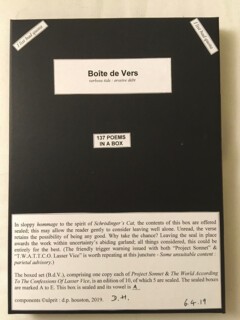Thinking inside the Box
Gill Partington
I received d.p. houston’s poetry collection Boîte de Vers in the post last week. It’s completely unreadable, but not in the sense that it’s bad. It could well be, but I have no idea because it comes in a sealed box, ‘in sloppy hommage to the spirit of Schrödinger’s Cat’. There are apparently five of these boxes in circulation; mine is lettered A. The precise nature of its contents is indeterminate. I could break the seal of strong black tape and open the box, but doing so would alter it. Not least because I would then be required to fill in the attached label with a cross or tick ‘to indicate whether or not the intrusion comes to be regretted’. It feels like a puzzle, or a personality test: what kind of person would open the box?
‘The books in the box are real and the work within almost entirely unknown in this country,’ the accompanying print-out says, with a tantalising picture of the contents unsealed, but face down. There are 137 poems, which seem to be divided into two sequences: ‘The World According to the Confessions of Lasser Vice’ and ‘Project Sonnet’. They sound intriguing and funny. Possibly a bit dirty, too, as the collection comes with a ‘friendly trigger warning’ of ‘some unsuitable content: parietal advisory.’ (Not a typo, but wordplay: ‘parietal’ means relating to a partition, or a walled-off cavity or container.)
Books in boxes are rare, but not unheard of. B.S. Johnson’s The Unfortunates (1969) may be the best known example. Its separate, unbound chapters can be rearranged in any order. Marc Saporta’s Composition Number 1 was published earlier in the 1960s and, more experimentally, allowed readers to treat its loose-leaf pages either as stand-alone narratives or part of a sequence. More recently, Anne Carson’s Nox (2010) used a box to house its long, accordion-folded meditation on grief and translation. Chris Ware’s Building Stories (2012), part model, part graphic novel, is meant to be assembled and played with as much as read.
But Boîte de Vers is a different proposition. The box is not a mechanism to free the book from the constraints of the binding, but the reverse: a way to entomb it. Not to make it readable in a different way, but to prevent reading entirely. Comparisons are hard to come by, but I’m reminded of an item I encountered recently in the Cambridge University Library Special Collections. The Hyakumantō darani (FG.870.1-4) are among the oldest printed texts in the world, Buddhist invocations made using a woodblock in Japan in the eighth century. But they weren’t meant to be read. Thousands were produced, and each sealed inside the hollow body of a miniature wooden pagoda, about four inches high, then placed in a temple. The text inside was concealed from human eyes. Its hiddenness is what gives it power.
Boîte de Vers works in a similar way, breaking the circuit between reader and writer in a way that generates a frisson, or frustration, depending on your perspective. It’s a conundrum, hovering between one state and another. While it remains sealed, it’s ‘a conceptual piece intended as an incarnation of obscurity’. It’s less a work of literature than an artistic provocation. The uncertainty is the point of this quasi-literary object. The contents could be mind-blowing or mediocre but, as the notes on the outside of the box put it, ‘why take the chance?’ Boîte de Vers translates literally as ‘box of verse’, but it’s also the French for ‘can of worms’.

Comments